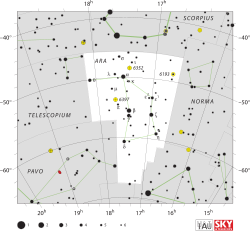Ara (constellation)
| Constellation | |

|
|
| Abbreviation | Ara |
|---|---|
| Genitive | Arae |
| Pronunciation | /ˈɛərə/, genitive /ˈɛəriː/ |
| Symbolism | the Altar |
| Right ascension | 16h 34m 16.9497s–18h 10m 41.3407s |
| Declination | −45.4859734°–−67.6905823° |
| Family | Hercules |
| Area | 237 sq. deg. (63rd) |
| Main stars | 8 |
|
Bayer/Flamsteed stars |
17 |
| Stars with planets | 7 |
| Stars brighter than 3.00m | 2 |
| Stars within 10.00 pc (32.62 ly) | 3 |
| Brightest star | β Ara (2.84m) |
| Nearest star |
Gliese 674 (14.80 ly, 4.54 pc) |
| Messier objects | 0 |
| Meteor showers | None |
| Bordering constellations |
|
|
Visible at latitudes between +25° and −90°. Best visible at 21:00 (9 p.m.) during the month of July. |
|
Ara (Latin: "The Altar") is a southern constellation situated between Scorpius and Triangulum Australe. Ara (Greek: Βωμός) was one of the 48 Greek constellations described by the 2nd century astronomer Ptolemy, and it remains one of the 88 modern constellations defined by the International Astronomical Union.
The orange supergiant Beta Arae is the brightest star in the constellation, with an apparent magnitude of 2.85—marginally brighter than the blue-white Alpha Arae. Seven star systems host planets. The sunlike star Mu Arae hosts four planets, while Gliese 676 is a binary red dwarf system with four planets. The Milky Way crosses the northwestern part of Ara.
In ancient Greek mythology, Ara was identified as the altar where the gods first made offerings and formed an alliance before defeating the Titans. The nearby Milky Way represents the smoke rising from the offerings on the altar,
Ara is one of the southernmost constellations depicted by Ptolemy. It had been recorded by Aratus in 270 BCE as lying close to the horizon, and the Almagest portrays stars as far south as Gamma Arae. Professor of astronomy Bradley Schaefer has proposed that ancient observers must have been able to see as far south as Zeta Arae to define a pattern that looked like an altar.
In illustrations, Ara is usually depicted as an altar with its smoke 'rising' southward. However, depictions of Ara often vary in their details. In the early days of printing, a 1482 woodcut of Gaius Julius Hyginus's classic Poeticon Astronomicon depicts the altar as surrounded by demons.Johann Bayer in 1603 depicted Ara as an altar with burning incense; the flames rise southward as in most atlases. Hyginus also depicted Ara as an altar with burning incense, though his Ara featured devils on either side of the flames. However, Willem Blaeu, a Dutch uranographer active in the 16th and 17th centuries, drew Ara as an altar designed for sacrifice, with a burning animal offering. Unlike most depictions, the smoke from Blaeu's Ara rises northward, represented by Alpha Arae. A more unusual depiction of Ara comes from Aratus, a Greek uranographer, in 270 BCE. He drew Ara as a lighthouse, where Alpha, Beta, Epsilon, and Zeta Arae represent the base, and Eta Arae represents the flames at the lighthouse's light.
...
Wikipedia
